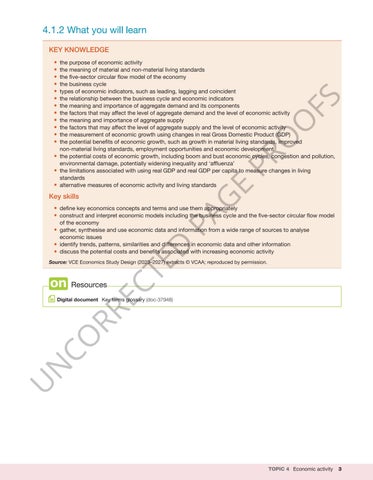“c04EconomicActivity_PrintPDF” — 2022/5/28 — 13:00 — page 3 — #3
4.1.2 What you will learn KEY KNOWLEDGE • • • • • • • • • • • •
E
PR
O
O
FS
the purpose of economic activity the meaning of material and non-material living standards the five-sector circular flow model of the economy the business cycle types of economic indicators, such as leading, lagging and coincident the relationship between the business cycle and economic indicators the meaning and importance of aggregate demand and its components the factors that may affect the level of aggregate demand and the level of economic activity the meaning and importance of aggregate supply the factors that may affect the level of aggregate supply and the level of economic activity the measurement of economic growth using changes in real Gross Domestic Product (GDP) the potential benefits of economic growth, such as growth in material living standards, improved non-material living standards, employment opportunities and economic development • the potential costs of economic growth, including boom and bust economic cycles, congestion and pollution, environmental damage, potentially widening inequality and ‘affluenza’ • the limitations associated with using real GDP and real GDP per capita to measure changes in living standards • alternative measures of economic activity and living standards
G
Key skills
TE
D
PA
• define key economics concepts and terms and use them appropriately • construct and interpret economic models including the business cycle and the five-sector circular flow model of the economy • gather, synthesise and use economic data and information from a wide range of sources to analyse economic issues • identify trends, patterns, similarities and differences in economic data and other information • discuss the potential costs and benefits associated with increasing economic activity Source: VCE Economics Study Design (2023–2027) extracts © VCAA; reproduced by permission.
CO RR EC
Resources
Resourceseses
U
N
Digital document Key terms glossary (doc-37948)
TOPIC 4 Economic activity
3





















































